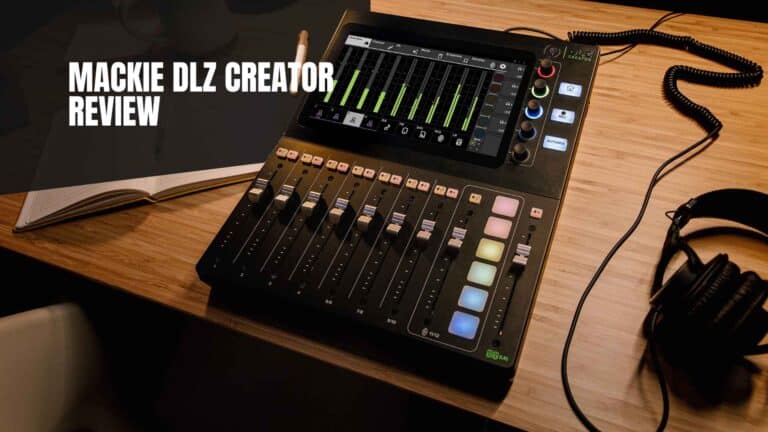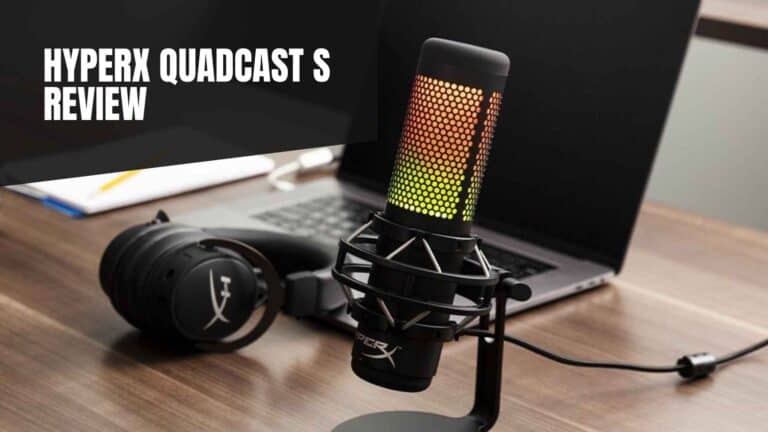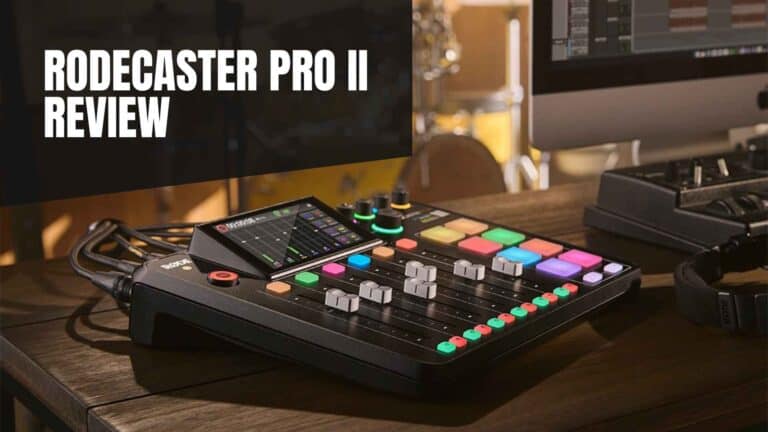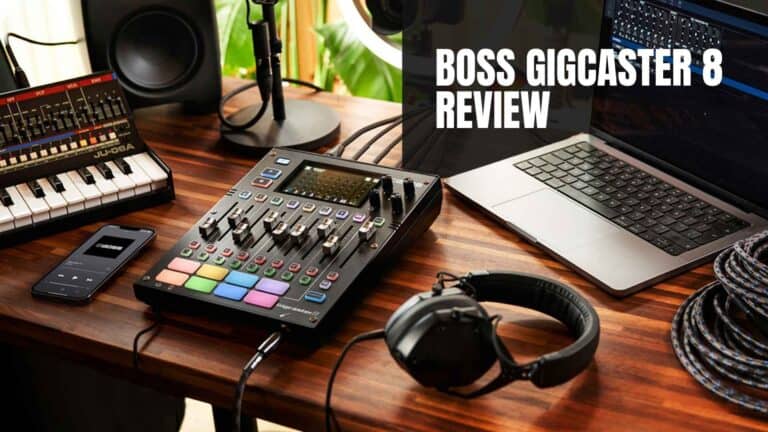Rode NT1 5th Generation Review: A Remake of the Classic Mic

The Rode NT1 is a name that resonates with audio enthusiasts and professionals alike. The first generation of the NT1 was introduced by Rode (known as Freedman Electronics back then) in 1991 after sourcing and modifying some large diaphragm condenser mics he found in China 10 years before. This brought affordable mics to the masses and ushered in an era of home recording.
Now, with the release of the Rode NT1 5th Generation, Rode has decided to give this classic mic a modern twist, and I’m going to give my take on this incredible mic.
In this Rode NT1 5th Generation review, we’ll dive into the nitty-gritty of this mic, exploring everything from its aesthetics to its sound quality and some of its nifty new features. So, let’s get right into this Rode NT1 5th Generation review – a remake of a classic mic that’s ready to take the stage once again.
At a Glance
The Rode NT1 5th Generation mic elegantly blends tradition with innovation, keeping its classic design and maintaining its crisp and smooth audio with a rich and deep bass that NT1 lovers are accustomed to. It has become a versatile microphone that can be used for streaming, studio, and home recording.
Priced at $249, the Rode NT1 5th Generation outclasses its previous generations of NT1 XLR mics with new technological upgrades. These include dual connectivity with a newly added USB-C port for easy plug-and-play recording without requiring an audio interface, onboard DSP that allows for studio-grade audio processing through Rode’s APHEX processor, and 32-bit digital float output for dealing with clipping audio.
Pros
Cons
Design and Build Quality
The Rode NT1 5th Generation mic, manufactured in Rode’s state-of-the-art facility in Sydney, is a remarkable piece of engineering that continues the legacy of its NT1 predecessors. At first glance, I actually mistook it for an NT1 4th Generation, as they look so similar. However, upon closer inspection, the subtle differences become apparent.

The Rode NT1 5th Generation introduces a fresh change in design by combining a matte black finish with a silver mesh grill. This combination adds a touch of elegance, distinguishing it from the previous all-black or all-silver designs. For those who prefer the iconic look, the option for the classic all-silver finish remains available.
The Rode NT1 5th Generation still maintains its clean and uncluttered appearance with the absence of physical microphone controls like dials, buttons, or switches. There is a golden dot on the NT1 that indicates the front of the microphone to which you should speak.
The build quality of the Rode NT1 5th Generation mic is impressive, as always. Machined from rugged aluminum, the body is both sturdy and robust yet surprisingly lightweight. There is a significant weight reduction from 0.97 lbs (440g) in the 4th Generation to 0.68 lbs (308g) in the 5th Generation, as if the old NT1 decided to go on a major weight loss program.
This weight reduction from the 4th to the 5th Generation of NT1 is also remarkable because the NT1 5th Generation houses a mic preamp, analog-to-digital converter (ADC), and a digital signal processor (DSP), features that the NT1 4th Generation does not have.
Its mesh grill is also very durable and protects its 1-inch HF6 large diaphragm condenser capsule, ensuring longevity and consistent performance.
I’m not surprised that Rode is willing to give a 10-year warranty on this microphone. They’re so confident in the build quality of this remarkable microphone that they’re willing to stand behind it for a decade.
Included Accessories
The Rode NT1 5th Generation mic comes with an array of accessories that complement the microphone and enhance its functionality. This includes a drawstring microphone pouch, an SM6 shock mount with 5/8” and 3/8” thread adapter, a pop filter, a USB-C to USB-C cable, and a beautiful red-colored Rode XLR-6 cable.
I love that Rode provides very high-quality accessories, which significantly enhance the overall value of the microphone, compared to other microphone brands that sometimes throw in cheap accessories that don’t function well.

The provided all-metal SM6 shock mount is highly effective at reducing any accidental bumps and knocks on your desk. It is also compatible with the Rode PSA1, a high-quality boom arm that does not sag easily.
Similar to the NT1 4th Generation, the shock mount has an adjustable adapter at the front for attaching the pop filter. The angle of the pop filter and the adapter can be adjusted forwards or backward, and the pop filter has a nifty telescopic feature that allows it to be moved up and down. Additionally, the pop filter’s two layers of mesh are highly effective against plosives, ensuring clear audio quality.
The provided Rode XLR-6 cable is of professional-grade quality that uses a Canare cable with high-quality Neutrik connectors. This ensures extremely low noise for ultra-clean signal transfer, a feature that distinguishes it from standard XLR cables.
For those whose computers only have USB-A ports and no USB-C ports, an adapter or a USB-C to USB-A cable may be required. This is a minor consideration but worth noting to ensure compatibility with your existing setup.
It is also great that Rode included a drawstring pouch, which can be used not only for transporting your mic but also as a dust cover when you want to leave your microphone setup in place for a period of time.
However, there’s no provided microphone stand, so you’ll have to get one or a boom arm before you can start using this mic properly.
Connectivity Options

The Rode NT1 5th Generation mic has a new and clever connectivity option not seen in any other microphone before. It has the standard XLR port at the bottom of the microphone, much like the previous models, which you can use to connect to an audio interface, mic preamp, or audio mixer. However, the 5th Generation adds a new dimension by discreetly housing a USB-C port within the XLR port, making this a hybrid XLR and USB microphone. Rode calls this feature the Dual Connect output and is still pending its patent application.

While the Dual Connect output is an intriguing and space-efficient design, it does present a slight challenge. The specific size of the USB output means that only the provided USB-C cable by Rode can fit into it. Other USB-C cables may not be compatible, leading to potential difficulties if you misplace the original cable.
The new Rode NT1’s light weight, compactness, and USB connectivity make it a very portable microphone. And unlike other portable USB microphones, such as the Elgato Wave:3 or the HyperX Quadcast S, the Rode NT1 is widely recognized and trusted for professional use. This trust factor elevates it above many other USB microphones in the market.
However, there are some limitations to consider. Despite being a USB mic, the Rode NT1 5th Generation lacks a headphone jack for zero-latency monitoring, a feature that is crucial for music production.
You will need to plug your headphones into your computer and select the low-latency option on RodeConnect, which may still result in some lag, particularly when running multiple tracks on a Digital Audio Workstation (DAW).
Fortunately, you can still get zero-latency monitoring by connecting the XLR output to an audio interface or mixer with a headphone monitoring output.
Sound Quality
The Rode NT1 5th Generation mic is a remarkable instrument that offers a sophisticated blend of features to ensure optimal sound quality.

Utilizing Rode’s proprietary ultra-low noise and high-gain Revolution Preamps, also found in other Rode devices like the RODECaster Pro II audio mixer, the Rode NT1 5th Generation can achieve an impressively low self-noise of 4dB and a high SPL of 142 dB. This makes it near impossible to overdrive the microphone’s circuitry, allowing you to get an incredibly clean signal, even when you crank up the gain or add a lot of compression.

The microphone’s high SPL capability allows it to handle a wide range of loud instruments, including brass, snare drums, cymbals, and electric guitar amps. Furthermore, the low self-noise even allows for the normalization of a whisper to an audible level without introducing any hissing or buzzing.

The Rode NT1 5th Generation is equipped with a high-resolution analog-to-digital converter that supports up to 192 kHz, and it uses the same 1-inch HF6 large-diaphragm gold-sputtered capsule as the NT1 4th Generation, allowing it to have the same audio quality and tone as previous models that people would come to expect.
The HF6 capsule’s internal shock mounting, combined with the provided SM6 shock mount, significantly reduces noise from knocks and bumps.

The Rode NT1 5th Generation is a sensitive side-address mic that is smooth-sounding and has a cardioid pattern that effectively isolates your voice. Its sensitivity allows it to capture nuances in voice and instruments like an acoustic guitar that a dynamic microphone might miss, making it suitable for podcasting, vocals, acoustic instruments, and drums.
However, this sensitivity also presents challenges. Its off-axis rejection is not as robust as some dynamic microphones, such as the Shure SM7B, and it can pick up room noise in untreated environments; hence it would be imperative to have proper acoustic treatment for your home studio. Additionally, the microphone’s sensitivity to plosives requires careful handling and the use of a pop filter.

It has a flat frequency response with a slight boost in the higher frequencies, around 5kHz to 10kHz. Though the microphone is slightly mid-forward, it is not overly harsh. It offers crisp treble details and a rich bass presence that gives it a radio-like tone. However, you may find the need to attenuate the bass slightly in EQ if it’s too overpowering for you.
While the NT1 5th Generation mic does not provide the ‘shimmer’ or ‘brightness’ found in some premium condenser mics like the Neumann TLM 103 or Austrian Audio OC818, it does capture details in the upper frequencies with high clarity.
One amazing thing I felt was that the audio quality of the NT1 5th Generation remains consistent whether it is connected through XLR or USB. This really shows how good Rode’s Revolution Preamps are, as other hybrid USB and XLR mics like the Shure MV7 often suffer from inferior audio quality when using their USB connection.
It is worth noting that in USB mode, the Rode NT1 5th Generation uses its Revolution Preamps to boost the mic signal and does not require 48V phantom power, but you will still need phantom power from an audio interface or preamp when using it in XLR mode.
Microphone Features
The NT1 5th Generation is not short on features despite having no physical microphone controls. However, I do wish Rode would include some physical microphone controls, such as a gain dial, mute button, headphone jack, and volume control for it.
These mic controls are present in most USB mics like the Shure MV7, Elgato Wave:3, and HyperX Quadcast S. But I am guessing that Rode wants to keep the clean and classic look that the NT1 is known for while giving it USB versatility.
That being said, there’s quite a bit you can do with the NT1 5th Generation in USB mode, so much so that you might not even need the analog XLR option.
But still, having the XLR connector provides cleaner and higher-quality audio (actually, the audio quality in USB mode is so good that I can’t tell the difference), as well as the option to connect the microphone to analog outboard gear like tube preamps, compressors, and EQ.
Let’s take a look at two new features made possible by its USB connectivity:
32-bit Float Digital Output
The Rode NT1 5th Generation mic introduces a 32-bit float digital output selection when used in USB mode, and it’s nothing short of a game-changer. Gone are the days of fretting over perfect gain staging or obsessing over setting your gain to the exact right levels. Of course, you should still aim for an appropriate level of gain, but perfection is no longer a must.
This is because you can salvage an audio clip even if it exceeds 0 dBFS. Whether your audio is a soft whisper or a clipping scream, you can normalize the levels in post-production to make them clean and audible. It’s like having a safety net for your sound, allowing you to take risks and experiment without fear.

This feature is a dream come true for vocalists who love belting out rock or metal ballads with extreme dynamic ranges. Setting a healthy gain level that won’t clip during those powerful belts and screams has always been a challenge. But with the 32-bit floating point, that worry is a thing of the past.
While this feature is incredibly powerful, it’s not a magic wand that can salvage clipping audio from a live performance. Unfortunately, it is something that can only be done in post-production, requiring a DAW that supports 32-bit floating point. So, while it gives you more freedom and flexibility, it still encourages you to be mindful of your live performance.
On-board DSP

The Rode NT1 5th Generation also has a powerful on-board DSP (digital signal processing) that gives you access to Rode’s flagship APHEX processors like Big Bottom and Aural Exciter and other standard processors like compressor, high-pass filter and noise gate when using the mic in USB mode. The APHEX processor can also be found in other Rode devices like the RODECaster Pro II and Rode NT-USB+ condenser microphone.
The basic editor in APHEX lets you quickly achieve professional-grade audio with quick and easy customizations. You can adjust the gain, add a high-pass filter or adjust the depth, sparkle and punch to the audio.
The ‘Advanced’ controls give you standard audio processors like the compressor, noise gate, and EQ are great for polishing the audio quality. The noise gate can effectively remove almost all background noises, like keyboard typing, which is great for podcasting and streaming.
However, it is the Aural Exciter and Big Bottom that will really give your audio more character and take your audio to the next level.
The Aural Exciter affects the higher frequencies, making them sound boosted and giving more clarity and presence to your voice, while the Big Bottom enhances the low frequencies, adding richness and depth to your voice. When they are used together, your audio quality can really sound very different and more enhanced.
You can access these processors using the Rode Central, Rode Connect, or Rode Unify apps, but the Rode Connect app is probably the one you would want to use because it offers a nice balance of usability and features compared to Rode Central and Rode Unify.

With Rode Connect, you’ll feel like you’re using a virtual RODECaster Pro II, with access to sound pads, the APHEX processor, and the ability to mix multiple audio sources.
However, it’s worth noting that the digital signal processing doesn’t work at settings higher than 24-bit or 48kHz, so keep that in mind. And if you’re planning to use several USB mics with Rode Connect, you’ll need to install the ASIO driver.
One amazing thing about the DSP of the NT1 5th Generation is that the processor settings are stored inside the microphone even when you connect the mic to a different device.
Now, I must admit, I have a small gripe with these apps: they are so similar yet have different features among them. Rode Connect and Rode Unify, for example, allow you to connect multiple Rode USB-Mics and utilize the AHPEX processor and sound effects. But the Unify app gives you more routing options and access to submixes. It’s a bit like having three different remote controls for the same TV. I wish Rode would consolidate these features into one app instead of having three with overlapping features.
Final Verdict

The Rode NT1 5th Generation microphone represents a significant advancement in Rode’s classic line of NT1 microphones. With a legacy that spans decades, this latest iteration pays homage to its predecessors while introducing innovations that set new standards.
The design and build quality of the NT1 5th Generation are impeccable as always, and the combination of matte black finish on its aluminum body with silver mesh grille adds some freshness to its classic design.
The dual connectivity options are innovative and practical, although the proprietary USB-C connector may present challenges for some users. The inclusion of high-quality accessories enhances the overall value of the microphone, reflecting Rode’s commitment to providing a comprehensive package.
High-quality audio remains the hallmark of the NT1 series, and the 5th Generation does not disappoint. The low self-noise, high SPL, and sophisticated blend of features ensure optimal performance across a wide range of applications. The introduction of a 32-bit float digital output ensures safety in recovering clipping audio, and the onboard DSP with APHEX processors adds versatility and creative potential for your audio.
It’s an enhancement of an already incredible microphone, although I would really appreciate it if they included some practical microphone controls and outputs like a gain dial, mute button, and headphone jack with volume control.
Also, some other minor limitations include its sensitivity to room noise, the possibility that the USB-C connector might only accommodate the provided USB-C cable, the fact that salvaging clipping audio with 32-bit float can only be done in post-production, and the restriction that the DSP can only work up to 24-bit 48kHz.
However, these are minor issues that can be overlooked, given the amazing value this microphone provides, together with its high-quality accessories like its shock mount and pop filter, as seen in this Rode NT1 5th Generation review.
Production Information
Specifications
- Microphone Type: Hybrid Condenser
- Polar Pattern: Cardioid
- Diaphragm Size: 1″ (25mm)
- Power Requirements: USB bus powered, 48V phantom power
- A/D Resolution: 32-bit floating point/192kHz
- Frequency Response: 20 Hz to 20,000 Hz
- Sensitivity: -32 dBV/Pa (25.12 mV/Pa) @1kHz
- Max SPL: 142 dB
- Self Noise: 4 dB (A-weighted)
- Output Connection: XLR, USB-C
- Weight: 308g (0.68 lbs)
- Accessories: SM6 shock mount, XLR Cable, USB-C to USB-C cable, Dust Cover
Features
- Dual Connect XLR & USB connectivity
- 32-bit float digital output
- Onboard DSP with advanced APHEX controls for real-time audio processing
- Includes SM6 shock mount and pop filter

Rode NT1 5th Generation









